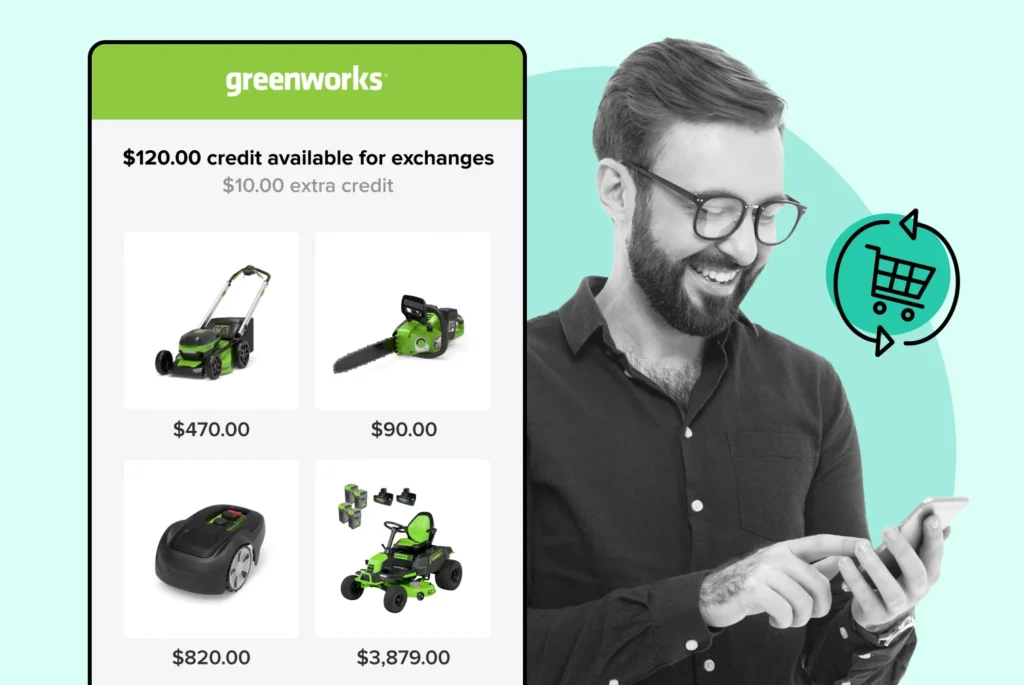
The Evolution of Returns Optimization in Ecommerce
Explore practical strategies for reducing return rates, streamlining the returns process, and enhancing your overall customer experience!
Shipping, Tracking & Notifications
Boost customer experience and reduce support tickets
Realtime order and shipment tracking
Proactive order and shipping notifications
AI-Enhanced Discounted Labels
Predictive pre-purchase estimated delivery dates
Self-Serivce branded order tracking
Effortless experience delivered
Identify and Resolve Order Issues
Realtime order and shipment tracking
Make returns profitable and delight customers
Flexibility to define any return destinations & conditions
Simplify returns for your customers and team
Incentivize exchanges over returns
Returns management made easy for your team
Returns management made easy for your team
Easy claims and smart upsells
Understand why your customers are returning
In-Store & Curbside Pickup
Unify the online and the in-store experience
Hassle-free pickup experience for customers
In-Store dashboard to keep operations streamlined
In-Store and Online orders unified
Drive foot-traffic to your stores
Shipping, Tracking & Notifications
Boost customer experience and reduce support tickets
Realtime order and shipment tracking
Proactive order and shipping notifications
AI-Enhanced Discounted Labels
Predictive pre-purchase estimated delivery dates
Self-Serivce branded order tracking
Effortless experience delivered
Identify and Resolve Order Issues
Realtime order and shipment tracking
Make returns profitable and delight customers
Flexibility to define any return destinations & conditions
Simplify returns for your customers and team
Incentivize exchanges over returns
Returns management made easy for your team
Returns management made easy for your team
Understand why your customers are returning
In-Store & Curbside Pickup
Unify the online and the in-store experience
Hassle-free pickup experience for customers
In-Store Dashboard to keep operations streamlined
In-Store and Online orders unified
Drive foot-traffic to your stores
Boost customer experience and reduce support tickets
Realtime order and shipment tracking
Proactive order and shipping notifications
AI-Enhanced Discounted Labels
Predictive pre-purchase estimated delivery dates
Self-Serivce branded order tracking
Effortless experience delivered
Make returns profitable and delight customers
Flexibility to define any return destinations & conditions
Simplify returns for your customers and team
Incentivize exchanges over returns
Returns management made easy for your team
Equip your team for precise return checks.
Easy claims and smart upsells
Understand why your customers are returning
Unify the online and the in-store experience
Hassle-free pickup experience for customers
In-Store Dashboard to keep operations streamlined
In-Store and Online orders unified
Drive foot-traffic to your stores
Find the answer to all your questions
Take a step by step trip through our functionality to see how we can improve your ecommerce processes.
Explore the most comon questions about WeSupply
Calculate the ROI that WeSupply can bring you
Read actionable articles on how to optimize your post-purchase experience and decrease support tickets
Get inspired by stories of how our customers implemented an effortless post-purchase experience
Wondering if WeSupply is a good fit for you? Read through our use cases to see how we can help you increase conversion & improve CX!
A Deep Dive into Top Companies' Order Tracking & Returns Strategy
Find the answer to all your questions
Explore the most comon questions about WeSupply
Calculate the ROI that WeSupply can bring you
Request a no strings attached review of your current shopping experience and missed conversion opportunities
Take a step by step trip through our functionality to see how we can improve your ecommerce processes.
Read actionable articles on how to optimize your post-purchase experience and decrease support tickets
Get inspired by stories of how our customers implemented an effortless post-purchase experience
A Deep Dive into Top Companies' Order Tracking & Returns Strategy
Wondering if WeSupply is a good fit for you? Read through our use cases to see how we can help you increase conversion & improve CX!

Maximizing ecommerce returns for retention can transform returns in ecommerce from a cost into a powerful retention tool. This article will explore how to turn your returns process into a strategic advantage by making it efficient, creating positive customer experiences, and using returns data effectively, all while focusing on maximizing ecommerce returns for retention.
Retention marketing is crucial in ecommerce due to its cost-effectiveness compared to customer acquisition, where a 5% increase in retention can boost profits by 25% to 95%.
Viewing returns as opportunities rather than costs can build customer loyalty and provide valuable insights, with 92% of customers more likely to repurchase after a positive return experience.
Simplifying and automating the returns process, offering multiple return options, and clear communication throughout can significantly enhance customer satisfaction and retention.
WeSupply maximizes retention through efficient returns by leveraging data-driven insights, simplifying processes, ensuring clear communication, encouraging exchanges, offering fast refunds, implementing sustainable practices, and integrating with review platforms. Enhance customer satisfaction and boost profits. Get started with WeSupply today!
In the fiercely competitive world of ecommerce, retention marketing has emerged as a critical strategy for sustainable growth and profitability. Retention marketing is significantly cheaper and more effective than acquiring new customers, costing 5 to 25 times less according to Harvard Business Review. This stark difference in cost efficiency underscores the importance of focusing on keeping existing customers happy and engaged.
Retention marketing aims to:
Foster strong relationships with customers
Boost customer loyalty
Encourage repeat customers
Set a positive cycle of growth and profitability in motion.
The ecommerce landscape is becoming increasingly crowded, and the competition for customers’ attention is fierce. This has led to a dramatic rise in customer acquisition costs. Customer acquisition costs have increased by 50% over the past five years, putting significant pressure on ecommerce businesses’ profit margins. This trend shows no signs of slowing down, with global spending on digital marketing projected to rise from $522.5 billion in 2021 to $836 billion by 2026.
Several factors contribute to this upward trend in acquisition costs. Increased privacy regulations and the removal of third-party cookies have made targeted advertising more challenging and expensive. Additionally, the average Cost-Per-Install (CPI) for mobile apps was $5.11 for iOS and $4.61 for Android in 2022, highlighting the substantial investment required to acquire new users across different platforms. These rising costs underscore the need for businesses to focus on retaining their existing customer base and maximizing the value of each customer relationship.
While acquiring new customers is becoming more expensive, the profitability of retaining existing customers has never been clearer. A study by Bain & Company found that increasing customer retention rates by just 5% can boost profits by 25% to 95%. This staggering statistic demonstrates the immense potential of focusing on customer retention strategies to boost customer retention. By keeping customers engaged and satisfied, businesses can significantly increase their Customer Lifetime Value (CLV) and improve their customer retention rate, a crucial metric in today’s competitive ecommerce landscape.
However, it’s important to note that not all retained customers are created equal. Differences in purchasing power and advocacy impact their profitability. Some loyal customers may demand more discounts and services, potentially eroding margins. In competitive markets, stealing share from rivals may offer higher returns than focusing primarily on retention. Therefore, a balanced approach that combines smart retention strategies with targeted acquisition efforts is often the most effective path to sustainable growth and profitability in ecommerce.
For many ecommerce businesses, returns have long been viewed as a necessary evil – a cost center that eats into profits and creates operational headaches. However, this perspective is rapidly changing as forward-thinking companies recognize the hidden potential in the return process. Returns, often seen purely as a cost, can be transformed into opportunities for building customer loyalty and gaining a competitive edge.
When businesses view returns as an opportunity to please customers and collect beneficial insights, they transform a potentially negative situation into a valuable resource for retention and expansion.
To fully appreciate the opportunity that returns present, it’s crucial to understand their true cost. Ecommerce returns can be costly for retailers, with processing costs ranging from 20% to 65% of the item’s original value. This significant expense is compounded by the fact that ecommerce return rates increased by 14% in 2022 compared to 2019, highlighting the growing scale of the issue. In the US alone, ecommerce returns amounted to approximately $102 billion in 2020, underscoring the massive financial impact on businesses.
The costs associated with returns go beyond just processing fees. Handling returns involves administrative costs including time and resources for processing, inventory management, and customer service. Returned items often need inspection, cleaning, and repackaging, leading to additional restocking and reprocessing fees. Moreover, indirect costs of returns can include lost sales, brand reputation damage, and environmental impacts. These multifaceted costs emphasize the need for businesses to develop strategies that not only minimize returns but also maximize the value that can be extracted from the return process.
While the costs associated with returns are significant, savvy ecommerce businesses are learning to view returns through a different lens – as opportunities for customer retention and loyalty building. An astounding 92% of customers are likely to buy again if they have a positive return experience. This statistic alone should be enough to make businesses sit up and take notice of the retention potential hidden within their return processes.
By reframing returns as a chance to engage and retain customers, businesses can transform a potentially negative experience into a positive one. An efficient return process is essential for customer satisfaction. It also helps to build trust in the company. Providing excellent customer service during the return process can turn a negative experience into a positive one, potentially creating a loyal customer for life.
Furthermore, brands can use the return process to gather valuable feedback for improving products and services, turning each return into an opportunity for business improvement and innovation.
In 2020, as COVID-19 accelerated e-commerce growth, EVEREVE faced significant challenges with high return rates typical in the fashion industry, which often exceeded 30%. The manual and fragmented returns process at EVEREVE led to inefficiencies, lack of visibility, and overwhelmed customer service teams.
The Challenge:
High return rates and a manual, time-consuming process.
Limited visibility into returns, causing issues in identifying return reasons and managing merchandise.
Overburdened customer service due to return-related inquiries.
The Solution: EVEREVE transformed its returns process with WeSupply’s Magento & Custom API integrations, automating returns and managing everything from a single interface. This approach focused on proactivity, self-service, and return flexibility.
Big Wins for Evereve:
Cost Savings: Reduced burden on customer service and fewer support tickets.
Faster, More Accurate Returns: Enhanced accountability and transparency by centralizing after-sale processes.
Streamlined Customer Experience: Improved order tracking, notifications, and in-store pick-up capabilities, leading to instant customer satisfaction and guaranteed sales.
Self-Service Returns: Empowered customers to handle returns independently, leading to increased customer loyalty.
EVEREVE’s new returns strategy, leveraging predictive analytics and automation, optimized shipping costs and reduced redundant processes, significantly enhancing employee productivity and overall performance.
In the age of big data, every interaction with a customer is an opportunity to gather valuable insights. Returns are no exception to this rule. Returns data can provide insights into customer behavior, such as why they are returning products and how often they do so. This wealth of information, when properly analyzed and acted upon, can be a goldmine for improving products, enhancing descriptions, and ultimately reducing return rates.
Embracing a data-driven outlook on returns allows businesses to convert a previously perceived obstacle into a potent instrument for ceaseless enhancement and customer gratification.
The first step in leveraging returns data is to thoroughly analyze return rates and reasons. Tracking the return rate enables businesses to measure customer satisfaction and identify the main reasons for returns. This information is crucial for understanding where improvements can be made, whether in product quality, description accuracy, or sizing guidelines. The average ecommerce return rate typically ranges between 20-30%, which is significantly higher than brick-and-mortar stores, emphasizing the importance of this analysis for online retailers.
Diving deeper into return reasons can reveal valuable insights. Common return reasons include:
Incorrect fit
Unmet expectations
Misdescribed products
Receiving gifts
Understanding these reasons can help businesses take targeted action to address issues. For example, luxury apparel and swimwear can see return rates as high as 50% due to the inability to try items on before purchase. This insight might lead a business to invest in virtual try-on technology or more detailed sizing guides.
Businesses can detect trends, identify problem areas, and devise strategies to lower returns and enhance customer satisfaction through diligent analysis of return data.
Once return data has been analyzed, the next step is to leverage these insights to make tangible improvements to products and descriptions. Returns data can help identify common complaints or issues with products, enabling businesses to make data-driven decisions for improvements. For instance, if a particular item has a high return rate due to sizing issues, this data can be used to adjust the product design or update the sizing chart to better align with customer expectations.
Product descriptions and images play a crucial role in setting accurate customer expectations. Return comments provide precise customer feedback, enabling specific adjustments in product descriptions to better match expectations. Analyzing frequently used words in return comments can help spot specific product issues that might otherwise be missed. For example, Silk & Salt used returns data to discover sizing issues in a product and worked with the manufacturer to make adjustments.
Businesses can notably decrease returns caused by unmet expectations by constantly enhancing product descriptions and images using return data, which results in better customer satisfaction and diminished operational expenses.
WeSupply helps eCommerce businesses harness data-driven insights by analyzing returns and logistics, enabling them to optimize their processes and improve customer satisfaction. With WeSupply, you can easily track and understand the key aspects of your business, leading to actionable insights and better decision-making.
Key Features:
Identify the most returned products
Understand why those products are returned
Identify which customers are serial returners
Reduce return rates with actionable insights
Track Customer Satisfaction (CSAT) and Net Promoter Score (NPS)
Analyze order flow with detailed breakdowns of received, shipped, canceled, and delivered orders
Monitor order “grey areas” like in transit, out for delivery, marked as exception, or waiting for pickup
Calculate processing time for each order by location for data-driven solutions
Order Flow Logistics Analytics:
Detailed breakdowns of order states: received, shipped, canceled, and delivered
Insight into order “grey areas” such as in transit, out for delivery, marked as exception, or waiting for pickup
Processing time calculations for each order by location
By providing these insights, WeSupply ensures that businesses can constantly fine-tune their operations to meet customer needs and deliver a seamless post-purchase experience.
In the world of ecommerce, convenience is king. This principle applies not just to the purchasing process, but to returns as well. Simplifying the returns process can significantly reduce customer frustration and improve their overall experience with the brand. Businesses can transform a potentially adverse experience into a positive one by ensuring returns are easy and trouble-free, which promotes customer loyalty and inspires repeat purchases.
We should examine some pivotal tactics for streamlining the returns process and enriching the customer experience.
Implementing an automated returns system can revolutionize the way businesses handle returns, offering benefits to both the company and its customers. Automating the return process allows for:
Maximum accuracy and speed with minimum manual labor
Reduced likelihood of errors
Significantly faster return process, leading to increased customer satisfaction
Automated processes like generating return shipping labels and sending return tracking updates
Minimized costs, making the entire returns operation more efficient and cost-effective.
Beyond operational efficiency, automated returns systems offer valuable insights and enhance the customer experience. An automated returns system provides valuable data-driven analytics, allowing businesses to track trends, identify problem areas, and make informed decisions to improve their products and processes.
From the customer’s perspective, automated systems provide:
Fluid communication, helping them feel supported during the returns process
Constant communication, coupled with the speed and accuracy of automated systems
Significant enhancement of customer satisfaction and loyalty.
Self-service return portals have emerged as a game-changer in the ecommerce returns landscape, offering convenience to customers and efficiency to businesses. A self-service return and refund platform can streamline the returns process for customers, allowing them to:
Initiate and manage their returns independently
Submit return requests
Receive notifications about refunds
Generate return shipping labels
This empowerment not only enhances customer satisfaction but also reduces the workload on customer service teams. Self-service return portals allow customers to handle their returns without needing assistance from customer service.
The benefits of self-service return portals extend beyond just convenience. Self-service return portals can:
Increase customer loyalty by providing a convenient and efficient returns process
Give customers control over their returns, building trust and demonstrating commitment to customer satisfaction
Drive traffic back to the retailer’s website, increasing opportunities for future purchases
This creates a win-win situation where customers enjoy a smooth returns process, and businesses benefit from increased website traffic and potential additional sales.
In the diverse world of ecommerce, one size rarely fits all, especially when it comes to returns. Offering multiple return options can cater to different customer preferences, which is essential for enhancing customer satisfaction. By providing a range of return methods, businesses can ensure that every customer can find a convenient way to return items, regardless of their location or circumstances. This flexibility can significantly improve the overall customer experience and increase the likelihood of repeat purchases.
Some examples of return options to consider are:
Prepaid return labels
Drop-off locations
Carrier pick-up services
In-store returns
Exchange options
By offering these different options, you can boost customer satisfaction by accommodating a wide range of customer needs and preferences, ultimately leading to higher customer satisfaction and loyalty.
Some effective strategies for offering multiple return options include:
Providing pre-paid label returns and options to ship with any carrier can cater to customer preferences. This allows customers to choose the most convenient shipping method for them.
Allowing customers to return items to physical stores can increase return convenience, especially for those who prefer in-person interactions or want to avoid shipping hassles.
Offering exchanges for the same product in a different size or color can help retain customers and revenue, turning a potential refund into a new sale.
By implementing a mix of these options, businesses can create a flexible and customer-friendly returns process that caters to a wide range of preferences and needs.
WeSupply simplifies the returns process, making it easy for customers and efficient for businesses. By automating and streamlining returns, WeSupply saves time, reduces errors, and enhances the overall customer experience.
Key Features:
Instant Credit for Exchanges: Encourage exchanges over refunds with instant store credit to save sales and boost average order value.
Branded Returns Portal: Provide a branded, omnichannel experience instead of using generic return tracking pages.
Self-Service Returns: Allow customers to control the return process, providing a frictionless experience.
Flexible Returns Rules: Create hassle-free return policies tailored to different use cases.
QR Code Return Labels: Simplify returns with autogenerated QR code labels, eliminating the need for printing.
Returns Tracking: Enable customers to track the progress of their returns easily.
Buy Online, Return In-Store: Offer convenient in-store returns for online purchases.
By providing these features, WeSupply ensures a seamless and efficient returns process that enhances customer satisfaction and loyalty. Experience Effortless Returns – Book a Demo with WeSupply Today!
In the realm of ecommerce returns, clear and consistent communication is the cornerstone of a positive customer experience. Effective communication throughout the returns process can significantly improve customer satisfaction and build trust in the brand. By keeping customers informed at every step of the return journey, businesses can alleviate anxiety, manage expectations, and transform what could be a frustrating experience into an opportunity to demonstrate excellent customer service.
Let’s explore the key aspects of clear communication in the returns process.
One of the most crucial elements of a smooth returns process is providing clear, easy-to-follow instructions and realistic timelines. A well-crafted return policy should use simple and concise language to ensure that customers easily understand the timeframe for returns, the condition of the product, and any associated costs or fees. This clarity helps prevent misunderstandings and reduces the likelihood of customer dissatisfaction.
When crafting return instructions and timelines, it’s important to consider several key factors. Here are some guidelines to follow:
Specify a clear time frame for returns, typically between 15 to 30 days, to manage customer expectations.
Clearly define the condition in which a product must be returned, such as being in its original packaging and unused, to prevent misunderstandings.
Outline the costs or fees associated with returns, like restocking fees or return shipping costs, to ensure customers have realistic expectations.
Businesses can foster trust and diminish potential disputes by creating a transparent returns process that provides this information beforehand.
Post-purchase communication plays a vital role in shaping the customer’s experience and can significantly impact their satisfaction with the returns process. Post-purchase communication:
Reassures customers about their purchase decisions
Reinforces trust in the brand
Helps prevent returns by addressing potential issues early
Smooths the path for returns when they are necessary
This ongoing dialogue is important for maintaining a positive customer experience and outstanding customer service throughout the customer journey.
Effective post-purchase communication strategies can take various forms. Here are some examples:
Sending a well-crafted ‘Thank You’ email after purchase helps in reinforcing the brand’s appreciation towards the customer.
Providing real-time order tracking information can reduce customer anxiety and improve satisfaction.
For returns specifically, regular updates on return progress can reduce customer anxiety and enhance satisfaction.
By leveraging automated email campaigns and social media engagement tools, businesses can enhance post-purchase communication, keeping customers informed and engaged throughout their journey, including during the returns process.
A clear, easily accessible return policy is crucial for setting customer expectations and building trust. A transparent and customer-friendly return policy can serve as a competitive advantage, encouraging customers to make purchases with the confidence that they can return products easily if needed. By prominently displaying and clearly communicating return policies, businesses can reduce uncertainty and increase customer confidence in their purchases.
To maximize the effectiveness of return policies, businesses should consider several strategies. Stating the return policy prominently on product and checkout pages reinforces customer understanding. Make sure the return policy is easily accessible from various parts of your website, including the homepage, product pages, and checkout page. This visibility ensures that customers can easily find and review the policy at any point in their shopping journey.
Highlighting your return policy on your website and during the checkout process can help reduce cart abandonment rates and improve overall sales. By making return policies clear and accessible, businesses can build trust with customers and potentially reduce hesitation in making purchases.
WeSupply ensures clear communication with customers, keeping them informed throughout the return process. By providing timely updates and clear instructions, WeSupply enhances customer satisfaction and reduces inquiries.
Key Features:
Post-Purchase Notifications: Send email and SMS notifications with a high open rate to keep customers informed and engaged.
By leveraging these features, WeSupply ensures customers are always in the know, leading to a smoother and more satisfying return experience.
Create custom return policies
There are many moving pieces in ecommerce logistics. Book a quick call with our experts to see how WeSupply can help you take control by creating custom policies to handle them all easily. You get to decide how you want to handle final sale items, return window lengths, return request approvals, and more.
While refunds are sometimes necessary, encouraging exchanges can be a powerful strategy for retaining customers and preserving revenue. A strong ecommerce exchange policy can prioritize revenue retention and customer loyalty by:
Encouraging exchanges over refunds
Maintaining customer engagement with the brand
Possibly converting a return into a fresh sale by directing customers towards exchanges instead of outright refunds.
Implementing an effective exchange strategy requires a multifaceted approach. Providing user-friendly return portals and flexible shipping options can promote exchanges over refunds. These tools make it easy for customers to explore alternative products and complete exchanges with minimal friction. Offering incentives like exclusive offers, rewards, or loyalty points can encourage customers to choose exchanges. These incentives can make exchanges more attractive than refunds, nudging customers towards continued engagement with the brand.
To maximize the effectiveness of an exchange-focused strategy, businesses should:
Leverage data and personalization
Analyze exchange data and customer feedback to optimize exchange strategies and improve customer satisfaction
Use data to inform product recommendations and guide improvements to the exchange process
Provide personalized recommendations and proactive customer support to enhance the exchange process
Transform returns from a potential loss into an opportunity for continued customer engagement and sales
By combining these strategies, businesses can maximize the benefits of their exchange-focused strategy.
WeSupply encourages exchanges over refunds, helping businesses retain customers within their ecosystem and boosting sales. By simplifying the exchange process and offering incentives, WeSupply turns potential returns into opportunities for growth.
Key Features:
Convert Returns into Exchanges:
Exchange return items with any product
Reship the same item
Exchange for the same value item
Exchange for a higher valued item
Incentivize Exchanges Over Returns:
Reward customers who choose instant store credit over refunds
Redirect customers to your product catalog after initiating a return
Refund to Store Credit, Gift Card, or Coupon Code:
Offer refunds as store credits to encourage repeat shopping and build customer trust
Use store credit or gift card as partial payment to increase order value
By leveraging these features, WeSupply ensures a seamless exchange process, enhancing customer satisfaction and loyalty, ultimately boosting profit and ROI. Discover how much you can gain by using our ROI Calculator today!
While encouraging exchanges is beneficial, there will always be situations where refunds are necessary. In these cases, the speed and efficiency of the refund process can significantly impact customer satisfaction and trust. A swift and hassle-free return procedure can significantly enhance a customer’s perception of the business. Businesses can transform a potentially negative experience into a positive one by prioritizing quick refunds, which enhances the probability of future purchases and positive word-of-mouth.
Implementing a fast refund process requires a combination of efficient systems and customer-centric policies. Automating returns can reduce manual errors and expedite the refund process, ensuring that customers receive their refunds as quickly as possible. Providing multiple return options like in-store, postal mail, and pick-up services enriches the buyer experience and can speed up the refund process.
Additionally, fast refunds help mitigate negative shifts in customer behavior that might occur due to a prolonged or frustrating refund process. By prioritizing speed and efficiency in refunds, businesses can build trust, enhance customer satisfaction, and increase the likelihood of repeat business.
WeSupply’s Pre-built Return Policies streamline the refund process, providing fast refunds that build trust and customer satisfaction. By automating approvals and encouraging in-store returns, businesses can enhance efficiency and boost sales.
Key Features:
In-Store Returns: Increase foot traffic and upsell new products by encouraging customers to return items in-store.
Automatically Issue Refunds When Products Are Shipped Back: Streamline the return process by automatically issuing refunds once products are shipped back, enhancing operational efficiency.
With these features, WeSupply ensures a quick and efficient refund process that fosters customer trust and satisfaction. Explore our other Pre-built Return Policies to see how they can benefit your business today!
In today’s environmentally conscious market, implementing sustainable return practices is not just good for the planet – it’s good for business. Sustainable eCommerce returns help reduce the environmental impact of returns, appealing to eco-conscious customers and building trust. Businesses can distinguish themselves in the market and attract customers who favor sustainability by embracing eco-friendly return practices.
There are several strategies businesses can employ to make their return processes more sustainable:
Reducing packaging waste
Shipping returns in bulk
Implementing a ‘buy online, return in-store’ policy
Using on-demand return shipping labels
These approaches not only reduce the environmental impact but can also lead to cost savings for the business.
Beyond the logistics of returns, businesses can implement sustainability practices throughout their operations to reduce return rates. Some strategies to consider include:
Providing clear and detailed product descriptions and size guides to ensure customers make informed purchases
Reselling, refurbishing, and recycling returned items to reduce waste and potentially create new revenue streams
Setting SMART (Specific, Measurable, Achievable, Relevant, Time-bound) goals to track progress in sustainability efforts and achieve sustainability targets
By implementing these practices, businesses can reduce their environmental impact, appeal to eco-conscious consumers, and potentially reduce costs associated with returns.
WeSupply helps businesses implement sustainable return practices, optimizing the handling of returns and reducing environmental impact. By leveraging intelligent dispositions and convenient return options, WeSupply enhances efficiency and customer satisfaction.
Key Features:
Printerless Returns via QR Code: Enhance customer experience with QR code drop-offs at FedEx Office, Walgreens, and USPS locations.
Generate Return Labels Automatically: Enable customers to generate return labels effortlessly, ensuring smooth returns even when staff is unavailable.
Green Returns: Allow customers to keep low-cost items, saving on shipping costs and reducing waste.
Non-Returnable Items: Provide clarity on which items are returnable, eliminating uncertainty and unnecessary communication.
By adopting these sustainable return practices, businesses can minimize their environmental footprint while maintaining high levels of customer satisfaction.
Harnessing the power of customer feedback, particularly after a successful return or exchange, can be a powerful tool for building trust and attracting new customers. Incentivized reviews are collaborations where customers leave reviews in exchange for small rewards like discount codes, loyalty points, or store credit. This strategy can encourage customers to share their positive experiences with returns, potentially influencing other shoppers’ perceptions of your brand. However, it’s crucial to maintain transparency in this process.
Authenticity in reviews is critical, and incentivized reviews should be clearly labeled to maintain transparency. This ensures that potential customers can make informed decisions based on genuine feedback.
Encouraging customers to leave reviews after a positive return experience can significantly boost your brand’s reputation and attract new customers. An effective strategy is to request reviews by reaching out directly to customers via mailing lists or social media. This personal approach can increase the likelihood of customers taking the time to share their experiences. Additionally, one of the most effective methods to get reviews is simply asking customers directly for their feedback. This straightforward approach can yield surprising results, especially when customers have had a positive experience with your returns process.
To maximize the effectiveness of your review-gathering efforts, consider implementing a mix of strategies. Automating the review request process can help scale efforts and maintain consistency, ensuring that every customer who has a positive return experience is invited to share their feedback. Offering incentives like discounts or credits for writing reviews can significantly increase participation. However, it’s important to ensure that these incentives are for leaving honest reviews, not necessarily positive ones.
Personalizing review requests, such as sending a personal video message, can boost response rates by making customers feel valued and appreciated. By implementing these strategies, you can build a robust collection of positive reviews that showcase your excellent returns process and customer service.
Once you’ve collected positive reviews about your returns process, it’s time to leverage them in your marketing efforts. Positive reviews serve as social proof and can significantly influence purchasing decisions; 78% of shoppers consider them crucial. By showcasing these reviews, you can build trust with potential customers and alleviate concerns they might have about making a purchase, knowing that if they need to return an item, the process will be smooth and hassle-free.
There are numerous ways to effectively use positive reviews in your marketing strategy. Here are some ideas:
Create quote graphics and video testimonials from customer reviews to share on social media. These visually appealing formats can catch the eye of potential customers scrolling through their feeds.
Highlight positive comments on social media posts and use story highlights on Instagram and Facebook to ensure continuous visibility of customer satisfaction.
Use positive reviews in your email marketing campaigns to showcase the positive experiences of your customers.
Incorporate customer testimonials on your website to build trust and credibility.
Share positive reviews in your advertising campaigns to attract new customers.
These strategies can help you leverage the power of positive reviews to grow your business.
Curated review recap videos compiling multiple customer testimonials serve as dynamic showcases of customer satisfaction, providing a powerful tool for convincing potential customers of your excellent service. By strategically leveraging positive reviews across your marketing channels, you can turn your efficient returns process into a compelling selling point for your brand.
WeSupply’s integration with powerful review platforms helps encourage positive reviews post-return, driving sales and enhancing customer trust. By leveraging user-generated content and seamless review collection, businesses can boost their reputation and customer loyalty.
Key Features:
Loox: Drive sales with engaging user-generated content, from visual-centric reviews to referrals.
Judge.me: Easily and automatically collect reviews via web, email, push, and SMS notifications.
Stamped: Get product reviews, ratings & referrals, and reward your customers with points programs & VIP tiers.
Yotpo: Get customer reviews & referrals, and boost recurring sales with SMS marketing and subscriptions.
Okendo: Capture high-impact customer reviews & user-generated content and showcase them on your site.
Junip: Gather customer reviews via multiple channels and display them on your storefront in minutes.
Reviews.io: Collect and showcase genuine text & video reviews from your customers in under 10 minutes.
With these integrations, WeSupply enables businesses to turn returns into opportunities for positive feedback, ultimately enhancing their online presence and customer satisfaction. See the Impact of Positive Reviews – Book a Demo with WeSupply Today!
J.McLaughlin, an American sportswear brand, faced challenges with managing split shipments and providing a seamless return experience. WeSupply’s solutions included integrating with their Aptos ERP system to provide clear order tracking, automated returns, and a branded interface for customers. This reduced customer service inquiries and enhanced customer satisfaction.
Key Features:
Order Tracking and Split Shipment Management: Consolidate all shipments into one view, displaying all package statuses and estimated delivery dates.
Branded Tracking Page: Provide detailed information about each shipment, including tracking numbers and carrier details.
Proactive Notifications: Send timely, relevant, and accurate information about online purchases to keep customers informed.
Branded Returns Portal: Allow customers to initiate returns, exchange products, and print shipping labels with ease.
In-Store Returns: Drive additional revenue growth and foot traffic by enabling returns at physical locations.
These features helped J.McLaughlin decrease customer service inquiries, enhance customer satisfaction, and boost revenue. Read how WeSupply helped J.McLaughlin.
Humane, known for high-quality products and exceptional customer service, faced challenges with managing bundle item returns. Partnering with WeSupply, they integrated a comprehensive solution with their Shopify and NetSuite systems, simplifying the return process, improving customer communication, and reducing support queries.
Key Features:
Seamless Integration: Unified platform for managing returns by integrating with Shopify and NetSuite.
Bundle Returns Management: Efficient processing and tracking of returns for bundled items.
Proactive Communication: Timely and accurate updates on return and replacement statuses.
These features led to efficient return processing, enhanced customer satisfaction, and reduced customer service queries. Discover the full story of how WeSupply transformed Humane’s return process.
Combat inconvenience with proactivity & self service
Book a quick call with our experts to see how WeSupply can help you make returns easy for your customers with a beautiful, self-service solution that makes their experience easier while also providing new ways to lower costs and earn back revenue.
As we’ve explored throughout this article, the returns process is far more than just a necessary evil in ecommerce – it’s a powerful opportunity to build customer loyalty and drive long-term growth. By reframing returns as a retention strategy, businesses can transform a potential point of frustration into a competitive advantage. Making the returns process simple and easy to navigate increases the likelihood of customers shopping again, turning a single transaction into a long-term relationship.
The key to success lies in a holistic approach that encompasses every aspect of the returns process. Clear communication throughout the return process can reduce customer hassle and boost satisfaction, setting the stage for positive experiences even when things don’t go as planned. Personalizing the returns experience can help in retaining customers by making them feel valued and understood. Collecting and analyzing returns data can provide actionable insights to improve the customer experience, allowing for continuous refinement of your returns strategy. Businesses can not only lessen the costs associated with returns but also utilize them as a potent instrument for customer retention and business expansion by executing these strategies and incessantly aiming for improvement.
WeSupply maximizes eCommerce returns for retention by leveraging data-driven insights, simplifying return processes, ensuring clear communication, encouraging exchanges, offering fast refunds, implementing sustainable practices, and integrating with powerful review platforms. With WeSupply, businesses can identify the most returned products, understand why they are returned, and track order flow logistics. Automated returns save time, while instant credit for exchanges boosts average order value. A branded returns portal, self-service returns, flexible return rules, QR code return labels, and comprehensive returns tracking enhance the customer experience. Clear communication features, such as return policy visibility, returns tracking, and post-purchase notifications, keep customers informed and satisfied. Sustainable return practices, such as intelligent dispositions, printerless returns via QR code, and green returns, minimize environmental impact.
To reduce the cost of returns for your ecommerce business, consider implementing strategies such as offering detailed product descriptions and size guides, providing virtual try-on technologies for apparel, encouraging exchanges instead of refunds, and optimizing your packaging. Analyzing return data to identify and address common issues can also help prevent future returns.
Offering incentives like free shipping on exchanges, providing a slightly higher value in store credit compared to cash refunds, simplifying the exchange process through user-friendly portals, and offering personalized product recommendations based on the customer’s purchase history and preferences can effectively encourage customers to choose exchanges over refunds.
WeSupply displays the return policy on the order lookup page, allows customers to track return progress, clarifies return periods, indicates non-returnable items, and provides 24/7 support with clear instructions and proactive updates. Post-purchase notifications keep customers informed and engaged.
WeSupply converts returns into exchanges, encourages instant store credit, and redirects customers to the product catalog. It offers refunds as store credits, gift cards, or coupon codes to encourage repeat shopping and increase order value.
Yes, WeSupply does have an official Shopify App. You can download and begin to integrate it with your Shopify store.
Yes, WeSupply has an official extension for Magento. The WeSupply x Magento integration allows for automating order tracking experiences, reducing customer inquiries, automating shipping email and SMS notifications, and providing a fully branded order tracking experience
Yes, WeSupply has an official BigCommerce App. You can integrate WeSupply with your BigCommerce store to improve your post-purchase customer experience.
Learn How To Create Successful Post Purchase Email Campaigns
Build an effective post-purchase email flow that helps you increase customer satisfaction and drive revenue growth!

Explore practical strategies for reducing return rates, streamlining the returns process, and enhancing your overall customer experience!

By focusing on the 20% of issues causing 80% of your returns, you can implement targeted strategies for major improvements!

How to transform returns data into a powerful tool for refining your product descriptions and improving your bottom line!

Let’s discuss practical strategies businesses can implement to manage the significant environmental impact of eCommerce returns!

Ler’s explore strategies like carbon offsetting, bulk shipping, and returnless refunds to achieve sustainable performance!

This article will show you how to optimize the sales and return process for swimwear, boosting customer satisfaction and revenue!

Practical strategies to optimize returns and exchanges for online furniture stores, helping reduce costs and improve customer satisfaction.

This article unpacks how pre-paid labels can both improve the return experience for customers and streamline operations for retailers.

Discover through our comprehensive guide how recommerce is reshaping the retail space, driving economic value, and fostering environmental sustainability.